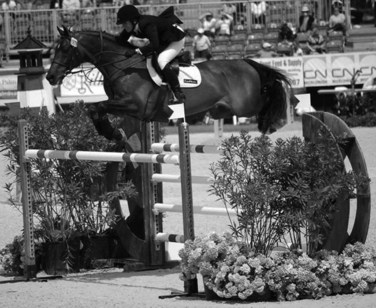Chapter 115Lameness in the Show Hunter and Show Jumper
Structure of the Sport
Show jumping combines athletic effort of the horse and rider. The scoring process is objective, with the winner jumping the course with the fewest rails knocked down and, in the jump off, in the fastest time. Heights of fences range from 1 m at novice level to 1.7 m for advanced competitions. The course should be completed within an allowed time, and some competitions are considered as speed classes in which jumping and time faults are combined. As the jumps get bigger, the potential for injury increases, and many conditions develop from repetitive strain. Many of the fences are set at distances to each other so that the horse must adjust stride length to fit in the appropriate number of strides. A good horse must have explosive power and great athleticism, combined with carefulness—a desire not to hit fences. Contrary to many equine sports, similar numbers of mares and geldings or stallions compete (Figure 115-1).
Characteristics of the Jumping Sports Horse
Many breeds are capable of show jumping and related activities and include Thoroughbreds (TBs), European Warmbloods, TB-Warmblood crosses, and American Quarter Horses and related crosses. The European Warmbloods most often are represented by the Hanoverian, Holsteiner, Trakehner, Dutch Warmblood, Selle Français, Swedish Warmblood, and Irish crossbred breeds. Breeding in continental Europe has become highly specialized and has developed in part through financial support from state governments. Most modern day top-level show jumpers are naturally well-balanced, good-moving athletes. Various pony breeds, such as the Welsh crosses, are used for children (see Chapter 126).
Training
Horses must learn to adjust stride length by shortening or lengthening the stride, to jump from a line perpendicular to a fence or at an angle, to turn quickly, to change leading legs in canter, and to jump from variable speeds of approach. Unwillingness to change leads or always favoring one lead when landing after a fence may indicate a problem (see Chapter 97). Much of the basic flat work training is similar to dressage.

 rim pad and either a heart bar shoe or a pour-in pad in an effort to keep the horses in work and competition (CBM).
rim pad and either a heart bar shoe or a pour-in pad in an effort to keep the horses in work and competition (CBM).


